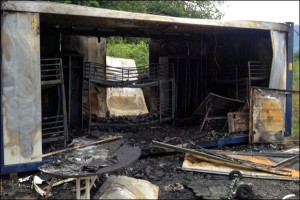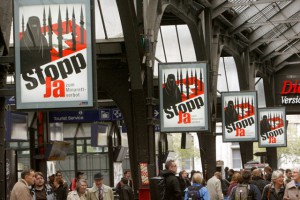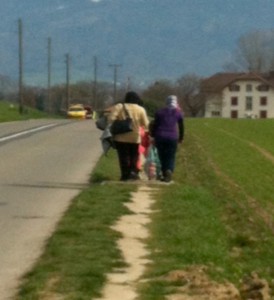Swiss asylum policy is characterised by institutional neglect within hostile systems designed to segregate and exclude.
Feras Farees Abedal Motaleeb was a Palestinian refugee who, having fled from Iraq to Switzerland to save his life, found death in a remote Swiss valley, in an 8m² space in a metal container which he shared with two other men. He was found with severe head injuries on 14 March 2013 in Waldau’s ‘minimal centre’, a collection of containers housing ‘recalcitrant’ asylum seekers (including addicts, alcoholics, mentally ill and violent men), with no permanent staff presence (someone comes round daily to distribute the subsistence allowance of ChF7.30).

The centre has a history of violence, with two fires and at least two stabbings before Feras’ death. But no-one is willing to take responsibility. The canton’s law enforcement head said it was not up to the migration authority to ensure the occupants’ safety.
The circumstances of Feras’ death testify to the extent of Swiss official hostility to asylum seekers and indifference to their safety, and the country’s apartheid-like policy of curfews and restrictions on asylum seekers’ movements. Switzerland, although outside the EU, participates fully in Europe’s anti-immigration and nativist zeitgeist. Tougher asylum laws, coupled with an increasingly xenophobic political culture, fuel a policy of segregation and inhumane treatment of asylum seekers.
Location, location, segregation
Rather than being accommodated in Switzerland’s multicultural cities, asylum seekers are sent to remote villages and even disused army bunkers in the Swiss Alps. And perhaps unsurprisingly, the locals often react to the arrival of asylum seekers with suspicion or outright hostility. Alpnach, in the canton of Obwald, is a case in point. In August 2013, the mayor commented of asylum seekers in a new centre there: ‘We don’t know how they behave, we don’t know if they are doing something that is against law … Could there be a conflict with asylum seekers getting in contact with school children?’ He told Swiss media that the community would retain the right to prohibit the new arrivals from freely accessing nearby schools, sports facilities, a retirement centre, and an entire neighbourhood. Such attitudes lay Swiss officials open to accusations of segregation and discrimination. A Guardian headline read, ‘Swiss segregation of asylum seekers: “we get less respect than an animal”’. The German newspaper Der Spiegel reported that ‘the town of Bremgarten in the Swiss canton of Aargau has banned asylum seekers from public swimming pools and sports facilities’, while the Doha-based Al Jazeera network echoed, ‘Asylum seekers not allowed to enter areas such as parks and pools in village near Zurich.’
From minaret bans to asylum restrictions
The flurry of anti-asylum activity in 2013 was not the first occasion that Switzerland had hit the international headlines for all the wrong reasons.

In 2009, more than 57 per cent of voters supported a Swiss Peoples Party (SVP) proposal to ban minarets. As many articles in the foreign media pointed out, the anti-minarets referendum took place in a country with a grand total of four minarets. Some in Switzerland hoped that the embarrassing anti-minaret vote was just a blip which might even prompt a backlash against the xenophobia and Islamophobia in the country, but they were to be proven wrong. Political events between mid-2013 and early 2014 have seriously undermined the Swiss Confederation’s self-image of humanitarianism and tolerance.
In June 2013, an overwhelming majority of Swiss voters backed a government move to tighten asylum restrictions. Military desertion was no longer to be a valid ground for seeking asylum in Switzerland (in 2012 ‘desertion had been the asylum ground most frequently cited by Eritreans, who accounted for most applications to Switzerland’). The stricter asylum rules also prevent asylum seekers from applying for asylum from Swiss embassies in their countries, bringing Switzerland into line with other European states in forcing victims of persecution and oppression to face the financial and logistical nightmare of travelling to the host country to request asylum. Some 79 per cent of voters were reported to have embraced the changes, although opponents of the tightened laws called the measures ‘inhumane’, according to Australia’s ABC.
Switzerland’s controversial policy of housing asylum seekers in military bunkers in isolated Alpine locations also came under the spotlight. As the Independent reported, ‘several Swiss army mountain bunkers have been decommissioned and turned into refugee centres. Critics point out that most of the bunkers are miles away from human habitation and that under current rules resident refugees are subjected to a curfew which forbids them from leaving the premises after 5pm’. Asylum seekers’ protests at these conditions were reported sympathetically by the world’s media; the China Post reported on ten demonstrators in the village of Solothurn who ‘spent five days protesting their living conditions in a windowless military shelter with insufficient ventilation’, while Fox News quoted Turkish Kurd Abdullah Ochalan: ‘There’s no air, no windows and thirty people sleeping together … That’s not the way it should be.’ In a report published on UNHCR’s Refworld website, Denise Graf of Amnesty International’s Swiss section spoke of asylum seekers being ‘holed up for nine months’ in underground military shelters like that in the Swiss village of Kestenholz, which ‘”stink, there’s no air, no light, and it’s always noisy”’.
That Amnesty International and UNHCR are focusing their attention on Switzerland’s apparent inhumane treatment of asylum seekers is an indictment of a country which is home to numerous humanitarian organisations and NGOs – including UNHCR itself.
Training – for cheap labour
We spoke to some of the residents of an asylum centre in the canton of Geneva. The state of Geneva houses asylum seekers in an isolated building in a field close to the French border. The Foyer d’Anières is designed to house 156 people, but there are reportedly 300 asylum seekers of forty-seven different nationalities living there at any given time. On the face of it, the Geneva authorities seem to be committed to the integration of asylum seekers and their children: infants living with their parents in the Foyer d’Anières benefit from the same state schooling as the children of company executives and bankers who reside in the affluent village of Anières. And while the children of asylum seekers sit in classrooms in the village school, their parents benefit from French lessons, Swiss culture lessons and even professional training. However, the provision of all this adult education is not as magnanimous as one may think: it is, as the website Signé Genève pointed out, designed to help fill ‘the economic sectors in which there is a shortage of labour … for example in the building industry, hospitality and catering and the cleaning industry’. Indeed, according to the Swiss Federal Office for Migration, 69 per cent of all construction workers in Switzerland do not hold a Swiss passport.
But if the integration of asylum seekers is the aim of Geneva’s state authorities, why do they choose to house victims of war and persecution in a building resembling a prison, far from the city of Geneva?
In another article on the Signé Genève website entitled ‘In Anières, asylum seekers and locals live side by side without any problems’, the writer points out that media reports linking crime and asylum centres in an ‘alarmist discourse’ bear ‘no resemblance to the reality’ of those living near the Foyer.[1]
Nevertheless, the Geneva authorities have not made it easy for the Foyer’s residents to get to Geneva city centre, providing little public transport, so that residents have to walk along a dirt path down a busy road, sometimes risking their safety, to get to the bus stop. It is reminiscent of the careless location of centres in Germany where at least three asylum seekers have lost their lives in the last three years having to cross unguarded railway tracks to get to local shops.[2]

A Macedonian resident of the Foyer d’Anières told IRR News that the asylum centre was an ‘open prison’. A family of Syrian refugees from the war-torn city of Aleppo explained that they had been in the centre for one and a half years, but despite obtaining residence permits, had been offered no alternative accommodation.
Isolation and thin air
But compared to the refugees in other Swiss cantons, the residents of the Foyer d’Anières are relatively fortunate. The most remote asylum centre in Switzerland, the Asylzentrum Lukmanier in the German-speaking part of the country, is an abandoned military bunker high up in the Swiss Alps at the top of the Lukmanier Pass. The website Vice News reported, ‘you can see nothing but an endless amount of rocks and a strangely shimmering black reservoir that is so cold your skin starts to burn as soon as you put your feet in it.

The only sound is the incessant buzzing of the high-voltage wires running through the small pylon that stands in front of the entrance’. Between fifty and eighty men are housed there, separated from wives and families, while they wait to find out whether they have been granted asylum.
According to the BBC, several ‘underground military bunkers dating back to World War Two … are in use as asylum centres’ in Switzerland. The BBC’s Imogen Foulkes reported from one of these isolated asylum centres in Realp, at an altitude of almost 2,000 metres, where asylum seekers ‘are expected to be inside the bunker by 17:00 and to stay there until 9:00 each morning’. Residents complained about the isolated location and the cramped conditions.
Land shortage or xenophobia?
Why are the Asylzentrum Lukmanier and the Realp centre located in the Swiss Alps, and why does the Foyer d’Anières sit ominously in the middle of a field, as if these buildings contained dangerous criminals or toxic waste? Why not house asylum seekers in one of the multicultural neighbourhoods of Geneva, Bern, St. Gallen, Zurich or Basel, where refugees would be able to mix with the local population, some of whom were themselves once asylum seekers? The Geneva authorities would probably retort by referring to the lack of land for new construction in Geneva. Others, however, would point to Swiss xenophobia.
For such a small country, Switzerland is a land of many superlatives, but they are not restricted to the financial, topographical or horological. Perhaps the most dubious distinction of the country is that it is home to one of Europe’s most powerful, far-right, populist, anti-immigration electoral parties, the Swiss People’s Party (SVP). That the SVP is also the largest and wealthiest political party in Switzerland is a reflection of something very wrong in Swiss society. The SVP’s ideas and propaganda should be anathema in a wealthy nation which boasts four national languages and which relies so heavily on foreign labour and foreign customers. The watchmaker Rolex employs numerous workers of non-Swiss origin, including many immigrants from Latin America, Asia, southern Europe and the former Yugoslavia as well as cross-border commuters from France. Nevertheless, xenophobia is being stirred up by the SVP, which is perhaps why the country’s asylum seekers are kept out of sight of the rest of the population. Switzerland’s inability to embrace diversity engenders a self-perpetuating cycle of mistrust, fear and paranoia which benefits the SVP. What better way to generate xenophobia and outright racism than to dump asylum seekers in isolated and prison-like edifices as if these people were too dangerous to be let loose among the general population?
Far-right agenda
In February 2014, the SVP scored another victory when its initiative ‘Against Mass Immigration’ was backed by 50.3 per cent of voters. Far-right parties including France’s Front National (FN) and Britain’s UKIP praised the Swiss. The FN leader Marine Le Pen is reported to have tweeted ‘The Swiss have said no to mass immigration, bravo!’ Far from being a model of humanitarianism and tolerance, Switzerland appears to have become the poster child for anti-immigration and nativist movements across Europe.
As conflict and oppression continue to wreak havoc in many parts of the world, this does not bode well for Switzerland’s asylum seekers who continue to languish in isolated and often degrading accommodation, out of sight and out of mind.
RELATED LINKS
Read an IRR News story: Swiss referendum: flying the flag for nativism
Read an IRR Briefing Paper: The Swiss referendum on minarets: background and aftermath (pdf file, 152kb)
Read an IRR News story: Swiss poll crushes minarets

Not worthwhile to comment. Never have I read such an arrogant and stupid nonsense. Have these guys ever been to Switzerland, yes do they know where Switzerland is? And what do they know about the problems with these immigrants, and what do they know about the SVP? NOTHING.
I read it and found it as a description of someone who has not expereinced any sideeffects of this process. Is not easy for the Refugee and understanding the process.
As for me (not poor, but university educated through scholarship) I got denied Asyl request in Switzerland, got kicked out as an “overstayed” inmigrant and returned to my “passport land”. Decided to get rid of documentation in the airport heading back and as a result I am still alive. But only surviving through an offshoring company and everything I use or do is manipulated and proffited by media, companies and society in general.
It is a process that does come easy, for both the country giving shelter and the one asking for it.
Howdy
I just checked out your website irr.org.uk and wanted to find out if you need help for SEO Link Building ?
If you aren’t using SEO Software then you will know the amount of work load involved in creating accounts, confirming emails and submitting your contents to thousands of websites.
With THIS SOFTWARE the link submission process will be the easiest task and completely automated, you will be able to build unlimited number of links and increase traffic to your websites which will lead to a higher number of customers and much more sales for you.
IF YOU ARE INTERESTED, We offer you 7 days free trial
CONTACT US HERE ==> dindinaa421@gmail.com
Regards,
Best Seo Software
Hi there
I Will Provide 20.000 Backlinks From Blog Comments for irr.org.uk,
By post 400k blog comments from where you will receive at least 20.000 live links.
– Use unlimited URLs
– Use unlimited keywords (anchor text)
– All languages supported
– Link report included
Boost your Google ranking, get more traffic and more sales!
IF YOU ARE INTERESTED
CONTACT US => lisaf2zw526@gmail.com